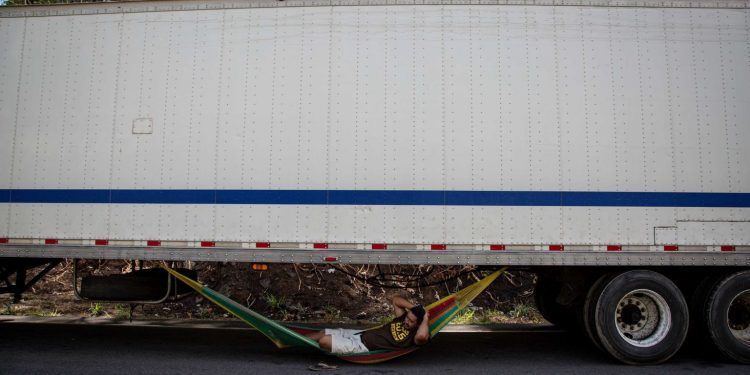An immense line of trucks stretches from the Peñas Blancas border to the town of Sonzapote de La Cruz, about 13 kilometers from the immigration control post with Nicaragua. It occupies the entire lane of descent, causing whatever vehicle passing through to drive against traffic, parking lights, a whistle that blows from time to time, in order to continue through to the official border crossing, which Nicaragua keeps closed.
It's 7:37 am on Thursday, March 21. Blanca Rostrán, 29, leaves her house in the community of Los Vertientes de Sonzapote. She carries a tower of sandwiches on her, an apron, and a sweet smile of braces. "It’s that we know almost all of them." A reason that she and her family consider good enough to raise money and give them food, fresh water, and coffee. Just today they made 330 ham and butter sandwiches.
Luis Recino and Ángel Ruano grab their sandwiches with shame and thank them three times. They are Guatemalan and arrived last night and got into the line that will one day take them back to their country. They say that when they entered from the northern border, they waited eight days for Costa Rica to test them for COVID-19. They managed to pass just before Nicaragua closed the entrance completely, a protest against the order of the Costa Rican Ministry of Health to prevent the entry of transporters beyond the border.
Peñas Blancas was already a very problematic border crossing, says the mayor of La Cruz, Alonso Alan. As he grew up in Las Vueltas, in that same section between the center of La Cruz and Peñas Blancas, he says that the community has always been used to the fact that “it is basically an area with a few services available for a whole day’s stay.” On top of that, he says, you have to add the constant lines, the delays in customs, and the little communication and coordination between Costa Rica and Nicaragua. "Suddenly the Nicaraguan side border will decide to close and then we are left to deal with everything," he would tell us later in his office.
To continue reading in Spanish, click here.
Una inmensa serpiente de furgones se extiende desde la frontera de Peñas Blancas hasta el pueblo de Sonzapote de La Cruz, a unos 13 kilómetros del puesto migratorio con Nicaragua. Ocupa todo el carril de descenso y entonces cualquier vehículo debe transitar contravía, luces de párking, pito de vez en cuando, para poder continuar hacia el puesto fronterizo oficial, que Nicaragua mantiene cerrado.
Son las 7:37 a. m. del jueves 21 de marzo. Blanca Rostrán, de 29 años, sale de su casa ubicada en la comunidad de Los Vertientes de Sonzapote. Lleva una torre de sánguches encima, un delantal y una sonrisa dulce, de frenillos. «Es que casi todos ellos son conocidos». Un motivo que ella y su familia consideran suficiente para recolectar dinero y regalarles comida, agua, fresco y café. Solo hoy hicieron 330 emparedados de jamón y mantequilla.
Luis Recino y Ángel Ruano agarran su sánguche como con pena y agradecen tres veces. Son guatemaltecos y llegaron anoche a la fila que algún día los llevará de regreso a su país. Dicen que cuando entraron desde el norte, esperaron ocho días a que Costa Rica les hiciera la prueba del COVID-19. Lograron pasar justo antes de que Nicaragua cerrara el paso por completo, una protesta contra la orden del Ministerio de Salud tico de impedir el ingreso de los transportistas más allá de la frontera.
Peñas Blancas ya de por sí era un puesto fronterizo muy problemático, asegura el alcalde de La Cruz, Alonso Alan. Como creció en Las Vueltas, en ese mismo tramo entre el centro de La Cruz y Peñas Blancas, dice que la comunidad siempre ha estado acostumbrada a que “es una zona básicamente con pocos servicios para permanecer todo un día”. Según él, a eso se suman las filas constantes, los atrasos en aduana y la poca comunicación y coordinación de acciones entre Costa Rica y Nicaragua. “De repente la frontera de lado nica decide cerrar y que nos quedamos con todo”, nos dirá más tarde en su oficina.
COVID-19 Update: The connection between local and global issues–the Pulitzer Center's long standing mantra–has, sadly, never been more evident. We are uniquely positioned to serve the journalists, news media organizations, schools, and universities we partner with by continuing to advance our core mission: enabling great journalism and education about underreported and systemic issues that resonate now–and continue to have relevance in times ahead. We believe that this is a moment for decisive action. Learn more about the steps we are taking.
